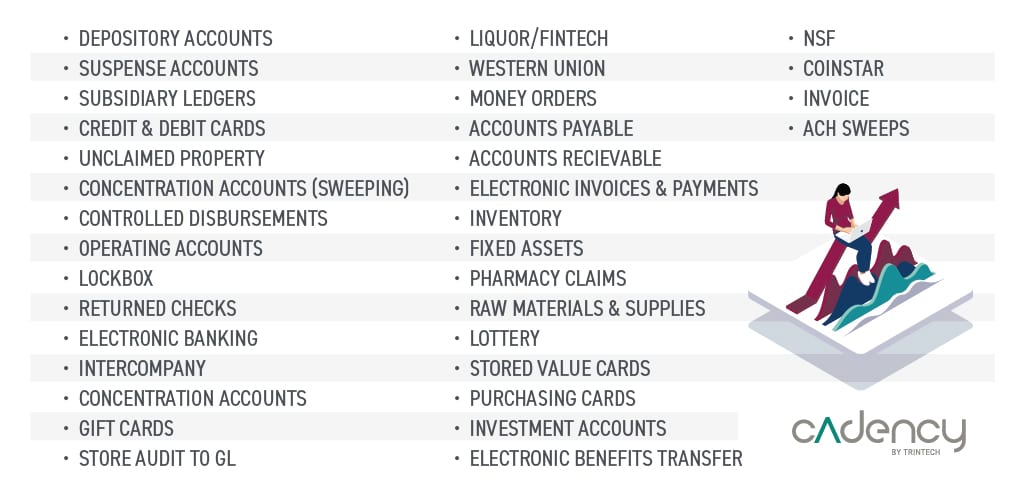4 Tips to Optimize Your Balance Sheet Reconciliation Process With Cadency® by Trintech
Blog post
Share
Are you optimizing your automated balance sheet reconciliation process to its fullest capacity?
After implementing Cadency® by Trintech, it can be easy for finance and accounting (F&A) teams to stop there. But in order for financial transformation to truly be successful and give organizations their fullest return on investment (ROI), F&A teams must continuously evaluate their current automation strategy.
Why You Should Continuously Update Your Automation Strategy
Implementing finance automation isn’t a one-stop shop; it’s a multi-phase transformation journey to a world-class financial close. Part of that transformation process is ensuring that your F&A teams are utilizing your Cadency solutions to the fullest capacity, not only to reduce (if not eliminate) the amount of manual work your accountants are doing but also to actively manage risk.
Fully optimizing your balance sheet reconciliation process ensures that your organization achieves the maximum ROI of Cadency.
Reconciliation Best Practice #1: Efficiently Match Transactions With Cadency Reconciliation Match®
Many F&A teams initially utilize Cadency Reconciliation Match to automate their bank and credit card reconciliations, but if you’re only using the balance sheet reconciliation software for those two categories, then you’re skimming the surface of the matching tool’s potential.
With Trintech, organizations can automate matching of:

“Today, we are loading about 100,000+ records and auto-reconcile over 90% of those intercompany reconciliations, which has been a significant win for us.” –LKQ Corporation
Transaction matching (as well as the overall account reconciliation process) is perhaps the most manual and time-consuming process of the financial close. To truly experience the full benefits that Cadency brings, F&A teams have to efficiently match transactions to the fullest, meaning they must expand their use of the automated matching tool’s capabilities. Take a look again at the list above — where else can you start to automate matching to get even more ROI out of your investment?
Reconciliation Best Practice #2: Reduce Manual Journal Entries
Another commonly lost ROI opportunity organizations make with Cadency Reconciliation Match is that they’re not utilizing the journal entry (JE) functionality. They might load their JE data into the platform, but they’re not using that data to automate their JEs. Cadency allows F&A teams to customize rules in order to automate JE posting and skip the manual JE efforts. This not only lightens the load of F&A teams but decreases risk introduced to the entire account reconciliation process.
Reconciliation Best Practice #3: Optimize the Greater Balance Sheet Reconciliation Process
When modernizing finance processes, many organizations fall prey to the same mistake: they automate transaction matching but fail to apply the same technology to the rest of the account reconciliation process. Essentially, F&A teams optimize half of the balance sheet reconciliation process but then return to time-consuming, manual approaches for the second half.
Stop limiting efficiency gains to only half the process, especially for account reconciliation.
Imagine the burden taken off F&A teams when the entirety of the most lengthy, frustrating part of the financial close becomes automated instead of 100% manually executed. Continue efficiency gains with Cadency Reconciliation Certify® and automate the rest of the account reconciliation process, balance sheet certification and variance analysis.
Reconciliation Best Practice #4: Take Advantage of Cadency’s Dynamic Account Maintenance (DAM) Functionality
Risk is dynamic; your organization’s risk profile is always fluctuating based on your internal processes and external circumstances, like constantly evolving compliance regulations. Organizations need a way to treat high risk balance sheet accounts in order to minimize risk for the organization while meeting their close deadlines — that’s where Dynamic Account Maintenance (DAM) functionality comes in.
DAM is a proactive technology, native to Cadency Reconciliation Certify, that dynamically identifies risk and adjusts the reconciliation process accordingly.
With DAM F&A teams can:
- Set If-and-Then rules based on your organization’s risk ratings. For example, you can set a rule for any accounts that exceed $200,000 to be routed to a workflow under a different manager for more frequent review. Then, when an account rises from $100,000 to $500,000 it is automatically reassigned to that manager.
- Evaluate an account’s current GL Balance and compare it against the organizational thresholds established by Admins prior to making any updates.
- Specify which Currency Bucket to evaluate during the financial close process. For example, CCY1 “Reporting”, CCY2 “Local”, CCY3 “Transaction”, etc. You can also set reconciliation parameters defined by different currency codes and regional thresholds. Finally, you can use FX Conversion Rates for Auto Bulk thresholds, retaining the increased efficiency from automation.
- Modify accounts based on advanced searches and make changes to the selected fields across multiple accounts at once
[cta-content-placement]
Treating high risk balance sheet accounts and maximizing efficiency should go hand-in-hand, and DAM will help your organization accomplish this.
Don’t Restrict Your F&A Team’s Potential by Limiting Your Efficiency Gains
It isn’t enough for automation to only efficiently match transactions for your F&A team; there are so many more opportunities for efficiency gains in the entire balance sheet reconciliation process that you may be missing out on. When you bridge the gap between your automation use and those uncovered efficiency gains, your team can move on from manual reconciliation methods to apply their high-level skills to more strategic activities.
Discover the full ROI your organization can experience with Cadency Reconciliation Certify.
Written by: Ashton Mathai






